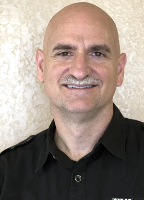
Set upon the Caddo Mills (Texas) Airport Testpad, Exos Aerospace’s new SARGE R2 rocket engine was ready for testing.
The company’s efficient, eight-man Operations Team prepared to conduct a 55-second engine run test. In the briefest moment, as the valves opened and the liquid oxygen mixed with the Ethanol fuel, the ambient noise was sucked into a vapor of silence, then blasted by the roar of a clean-burning engine.
For 15 seconds, the fiery exhaust gave a glimpse into the thrust that will fly the Exos’ SARGE R2 rocket. However, the impressive display of power was cut short by the failure of the LOX tank on the test stand, resulting in the near-instantaneous release of the liquid oxygen and ignition of the residual Ethanol in the supply lines between the tanks and the engine. This created all the pomp & circumstance expected of such an energetic event.
After the level-two Safety event was under control, the Exos team was in good spirits, as they seemed more focused on the new data and slight performance boost of the SARGE engine than with the theatrics that accompanied the test.

John Quinn
Co-Founder and COO, John Quinn, said the company knew the test-stand was nearing its end-of-life, but the failure will feed the firm’s Weibull analysis and will make our space vehicles more reliable as hard data points feed better models, resulting in better hardware understanding. If you can safely Run To Failure, it can provide both valuable data on in-service hardware and also offer financial benefits. Quinn relayed that the SARGE platform continues to serve as a capability demonstrator and risk mitigation program as the company proceeds to develop this reusable orbital rocket.
The Exos team team was well outside the blast zone and the engine survived with minimal damage. The test stand Ethanol and other supply tanks on the truck were unscathed by the blast. Though prognostic event prediction is far preferred, the failure provides valuable data that the team is working to extract from the test sleds memory. While the hope had been to obtain a few more uses out of the test stand, it served the company well, having supported more than 200 tests.
The cost savings of Running To Failure could pay for most of the materials needed to build several test stands, but the real value is understanding the operational Failure Mode.
Co-Founder Phil Eaton added that the company expected some improvements on this second SARGE build, but the engine ran at the high-end of our design range.
“She was hauling,” exclaimed safety officer Neil Milburn who has 20+ years deciphering the physics of many such engines.
The Texas-based rocket manufacturer is proving, once again, that high-performance space flight technologies can be developed on an accelerated timeframe, with a small efficient team, using their ExosWorks program structure. Their last SARGE reusable test flight marked the decommissioning of SARGE I. This was the fourth consecutive flight of the same rocket.
Exos stands with the three companies in the world that have flown the same rocket four times. SpaceX did it with 6,000+ employees, Blue Origin with a team of over 3,000, and Exos Aerospace (on a smaller scale, of course) with fewer than 20 employees.
Significant progress is being made to that end as EXOS has begun work through its first National Charter Enterprise Program in Italy (working with PricewaterhouseCoopers) and is working to replicate the effort in South Australia. The team will be applying their accelerated processes to orbital rocket development in a Special Economic Zone in the Basilicata region of Italy. The National Charter Enterprise model may mark the beginning of a new alternative to VC financing with Exos Aerospace poised to become a cost-effective microgravity provider, making SPACEavailable… to the world.

